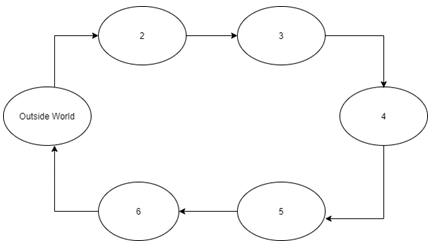This set of Cognitive Radio Multiple Choice Questions & Answers (MCQs) focuses on “ Architecture – Cognition Subsystem”.
1. Which among the following is not a part of the cognition subsystem?
a) Inference hierarchy
b) Cognition cycle
c) Organisation
d) Channel state
View Answer
Explanation: The information services exhibit cognitive behaviour by using a set of design rules, functions, and components defined by the cognitive radio architecture that allow continuous growth through easy updates. The section of the cognitive architecture responsible for cognitive behaviour consists of inference hierarchy, cognition cycle, and temporal organisation.
2. How does the cognition cycle operate?
a) Active
b) Reactive
c) Passive
d) Activated
View Answer
Explanation:The cognition cycle carries out its functions in a reactive sequence. Stimuli from the outside world are accepted by the sensors. The information is passed to the cognition cycle to generate a response.
3. Which among the following modes support real-time interaction?
a) Waking
b) Sleeping
c) Prayer
d) Prolong
View Answer
Explanation: The waking behaviour supports real time interaction with user and obtains real time input from the environment. It is also referred to as awake-state. However it does not imply a fixed state but a collection of behaviours.
4. What type of control is exhibited by awake-state of cognition subsystem?
a) Temporally different
b) Isochronous
c) Asynchronous
d) Serial
View Answer
Explanation: The awake-state or waking behaviour controls the cognitive radio resources isochronously. It maps the stored environmental interactions to the present input-response case being operated. Machine learning converts these interactions and cases into knowledge.
5. Which among the following modes should be invoked when a considerable period of disuse is expected?
a) Off
b) Prayer
c) Sleeping
d) On
View Answer
Explanation: When long periods of disuse are predicted, the cognitive radio should enter into sleeping behaviour by itself. The cognitive radio is trained to identify situations that require sleeping behaviour. It may seek permission before entering sleep mode.
6. What type of operations is performed in sleeping behaviour?
a) No operation
b) Non incremental machine learning
c) Incremental machine learning
d) Current knowledge generation
View Answer
Explanation: During sleeping behaviour, the radio processes the experience accumulated during the waking behaviour. This is accomplished by using non-incremental machine learning algorithms. It will map the present case integrated knowledge to overall integrated knowledge.
7. What is the responsibility of prayer behaviour?
a) Invoke sleeping behaviour
b) Invoke waking behaviour
c) Resolve conflicts
d) Erase present input-response behaviour
View Answer
Explanation: When the user chooses to disregard the decision taken by the cognitive radio, it is added to a list of conflicts. These conflicts may be resolved using overall knowledge developed during sleeping behaviour. Otherwise it is added to a list of unresolved conflicts which is resolved during praying behaviour.
8. What language is used by prayer behaviour to work with the home network while resolving a conflict?
a) Web Ontology Language
b) Radio Knowledge Representation Language
c) RoXen Macro Language
d) Knowledge Query and Manipulation Language
View Answer
Explanation: Prayer behaviour resolves conflict with the help of home network. The conflict is presented to the network using Knowledge Query and Manipulation Language. If the conflict is resolved, it is integrated into overall knowledge.
9. The entrance of a stimulus invokes a new cognition cycle.
a) True
b) False
View Answer
Explanation: The entrance of a stimulus invokes a new cognition cycle during the waking behaviour. It is also invoked by the completion of cognition cycle which was already in process. The stimulus is obtained by monitoring the information signals such as voices, images, radio signals, etc.
10. Match the numbered blocks with the correct word to complete the cognition cycle.

a) 2 – Orient, 3 – Observe, 4 – Decide, 5- Act, 6 – Plan
b) 2 – Observe, 3 – Orient, 4 – Decide, 5- Act, 6 – Plan
c) 2 – Orient, 3 – Observe, 4 – Decide, 5- Plan, 6 – Act
d) 2 – Observe, 3 – Orient, 4 – Plan, 5- Decide, 6 – Act
View Answer
Explanation: The major states or phases of the cognition cycle are observe, orient, plan, decide, and act respectively. The flow of control moves from observation to action. Certain situations demand for parallel operation of all states.
Sanfoundry Global Education & Learning Series – Cognitive Radio.
To practice all areas of Cognitive Radio, here is complete set of 1000+ Multiple Choice Questions and Answers.
If you find a mistake in question / option / answer, kindly take a screenshot and email to [email protected]
